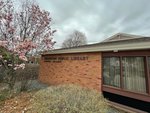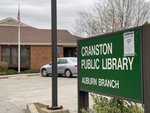By DANIEL KITTREDGE Its physical home may not be steeped in as much history as the William Hall Library or the Oak Lawn Branch, buildings that have stood for many decades. But the Cranston Public Library's Auburn Branch nonetheless has a long and rich
This item is available in full to subscribers.
We have recently launched a new and improved website. To continue reading, you will need to either log into your subscriber account, or purchase a new subscription.
If you are a current print subscriber, you can set up a free website account by clicking here.
Otherwise, click here to view your options for subscribing.
Please log in to continue |
|









Its physical home may not be steeped in as much history as the William Hall Library or the Oak Lawn Branch, buildings that have stood for many decades. But the Cranston Public Library’s Auburn Branch nonetheless has a long and rich story to tell.
The library began as the Auburn Reading Room in 1888, operating in a former fish market on Wellington Avenue north of Park Avenue, diagonally across from what was once the Church of the Ascension.
It’s had a number of homes in the following 133 years, including property at Park and Pontiac avenues now occupied by Crosstown Press, a renovated home at the corner of Park Avenue and Woodbine Street, and two different locations on Rolfe Square.
Then, on April 15, 1991, a ribbon-cutting ceremony attended by city officials and residents marked the opening of the Auburn Library’s current home at 396 Pontiac Ave., culminating a years-long search for a permanent location. It was the first time in the branch’s history that it had a home built specifically for use as a library.
Karen McGrath, Auburn’s branch librarian, has been a central player in the entirety of the storied library’s most recent chapter. With 35 years in her current role, she is the second-longest serving librarian in the branch’s history.
Last week, on April 15, she reflected on her time at Auburn – a place that has become “my second home” – as the branch celebrated its 30th anniversary.
She started as the branch librarian on Nov. 17, 1986, coming to Auburn, and Cranston, after starting her career as a reference librarian with the Providence Public Library. Being a librarian, she said, was something she “always planned on doing,” a career choice upon which she had her mind set at age 9.
She was initially hesitant about leaving Providence. “I wasn’t sure I wanted to be in a neighborhood branch,” she remembers. Her supervisor in Providence, whose husband worked in Cranston’s library system, encouraged her to pursue the opportunity at Auburn.
In the end, she said with a laugh, it was a conversation with her father about the pros and cons of the move that proved decisive.
“This won out because it had free parking,” she said, recalling the $300 she paid a year to park in downtown Providence in 1986.
More than three decades later, it’s clear McGrath chose well.
“I’ve been happy here ever since,” she said.
Last week’s 30th anniversary celebration lacked the formality and ceremony of the library’s 1991 ribbon-cutting, an event that drew “about 100 people, including politicians and trustees,” according to Suda J. Prohaska’s April 18, 1991, story in the Cranston Herald. While the building is open to visitors and Rhode Island’s pandemic outlook continues to improve, COVID-19 protocols remain in place.
Balloons and a sign at the entrance to the branch announced the milestone to those who stopped in, and each visitor received a gift packet containing an Auburn Branch word search, a pen, a bookmark, candy, and a sticker honoring the branch’s 30 years at 396 Pontiac Ave.
The packets also included information about membership in the Auburn Public Library Association and a small sheet of paper on which visitors were asked to write down what they “love about the Auburn Branch.”
Additionally, visitors were able to enter a raffle for $25 gift certificates from a number of Rolfe Square area businesses, including Artists’ Exchange, Sonia’s Near East Market, DELIcious, European Food Market & Deli, Chinese American Mini Mart, King’s Garden, Mesa Café and Durfee Hardware.
McGrath said that support from the local business community is an example of the Auburn Branch’s broader appeal. Its patrons, she said, are extremely loyal, which she attributes to their relationships with the staff, the walkability of the area and the close-knit feel of the branch itself.
“That’s what people like,” she said. “They like that it’s the neighborhood. They love that it’s nearby. They like that we know their names.”
She added: “People like this building because it’s small and cozy and friendly. The staff is friendly. And it’s a different feel … This is such a walkable neighborhood.”
At times, the devotion to Auburn is a microcosm of a broader Rhode Island dynamic – the resistance to traveling any distance, even just a couple of miles down Pontiac Avenue to Sockanosset Cross Road.
“I will say [to a patron], ‘Our copy of the book is out. It’s on shelf at Central. Would you like me to call over there, and you can run down and pick it up? They can hold it at the desk for you,’” she said. “And they will say, ‘No it is too far to go. Can you put it on hold and have it sent here?’ … It happens on a regular basis.”
Assistant Library Director Julie Holden, who stopped by Auburn for last week’s anniversary, seconded that assessment.
“The people here are adamant about coming to this branch,” she said. “This is their branch, and they won’t go anywhere else.”
Auburn’s draw for area residents is about more than its proximity, of course. While McGrath is the longest-serving member of the staff, others have been at the branch for several years. Names like Fran, Gail and Pat are well known to the library’s regular visitors.
“They all stay for years and years,” McGrath said of the branch’s staff. “The staff here is just wonderful. They’re so good. They’ve adapted to all of the coronavirus restrictions. They just roll with the punches … They’re great with the patrons.”
Most of all, the Auburn branch provides an invaluable resource for children and families in the area. Prior to the pandemic, McGrath noted, groups of students from nearby schools would come in during the afternoon to spend time, read, do work and talk with library staff.
“They like to have that adult to talk to when school is over,” she said, adding that she hopes those after-school visits can more fully resume soon.
Auburn is also a special place for the youngest children in the area. That aspect of the branch’s appeal, she said, has become generational.
“The people who were story hour kids when we started are now bringing their kids to storytime,” she said.
Much has changed since 1991, of course. According to Prohaska’s 1991 story on the ribbon-cutting ceremony, the city’s library system saw roughly 32,000 visitors each year at the time. As of 2020, that number had risen to 257,145, according to the 2020 annual report from the library system.
There’s more change to come, as Auburn and the rest of the city’s libraries emerge from the pandemic and adapt to a rapidly changing world.
But the history and tradition at Auburn – which McGrath documented, from 1888 on, on a whiteboard at the branch as part of the Cranston Public Library’s 50th anniversary in 2018, a process that took “about eight hours of combing through old records” – will remain, along with the mission of serving the community.
As McGrath says, “I’ve found my niche.”
Comments
No comments on this item Please log in to comment by clicking here